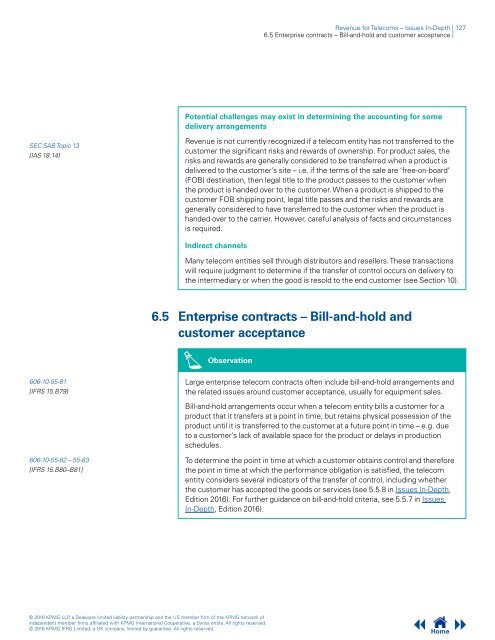Revenue for Telecoms
2cdncba
2cdncba
You also want an ePaper? Increase the reach of your titles
YUMPU automatically turns print PDFs into web optimized ePapers that Google loves.
<strong>Revenue</strong> <strong>for</strong> <strong>Telecoms</strong> – Issues In-Depth | 127<br />
6.5 Enterprise contracts – Bill-and-hold and customer acceptance |<br />
Potential challenges may exist in determining the accounting <strong>for</strong> some<br />
delivery arrangements<br />
SEC SAB Topic 13<br />
[IAS 18.14]<br />
<strong>Revenue</strong> is not currently recognized if a telecom entity has not transferred to the<br />
customer the significant risks and rewards of ownership. For product sales, the<br />
risks and rewards are generally considered to be transferred when a product is<br />
delivered to the customer’s site – i.e. if the terms of the sale are ‘free-on-board’<br />
(FOB) destination, then legal title to the product passes to the customer when<br />
the product is handed over to the customer. When a product is shipped to the<br />
customer FOB shipping point, legal title passes and the risks and rewards are<br />
generally considered to have transferred to the customer when the product is<br />
handed over to the carrier. However, careful analysis of facts and circumstances<br />
is required.<br />
Indirect channels<br />
Many telecom entities sell through distributors and resellers. These transactions<br />
will require judgment to determine if the transfer of control occurs on delivery to<br />
the intermediary or when the good is resold to the end customer (see Section 10).<br />
6.5 Enterprise contracts – Bill-and-hold and<br />
customer acceptance<br />
Observation<br />
606-10-55-81<br />
[IFRS 15.B79]<br />
Large enterprise telecom contracts often include bill-and-hold arrangements and<br />
the related issues around customer acceptance, usually <strong>for</strong> equipment sales.<br />
Bill-and-hold arrangements occur when a telecom entity bills a customer <strong>for</strong> a<br />
product that it transfers at a point in time, but retains physical possession of the<br />
product until it is transferred to the customer at a future point in time – e.g. due<br />
to a customer’s lack of available space <strong>for</strong> the product or delays in production<br />
schedules.<br />
606-10-55-82 – 55-83<br />
[IFRS 15.B80–B81]<br />
To determine the point in time at which a customer obtains control and there<strong>for</strong>e<br />
the point in time at which the per<strong>for</strong>mance obligation is satisfied, the telecom<br />
entity considers several indicators of the transfer of control, including whether<br />
the customer has accepted the goods or services (see 5.5.8 in Issues In-Depth,<br />
Edition 2016). For further guidance on bill-and-hold criteria, see 5.5.7 in Issues<br />
In-Depth, Edition 2016).<br />
© 2016 KPMG LLP, a Delaware limited liability partnership and the US member firm of the KPMG network of<br />
independent member firms affiliated with KPMG International Cooperative, a Swiss entity. All rights reserved.<br />
© 2016 KPMG IFRG Limited, a UK company, limited by guarantee. All rights reserved.<br />
Home







